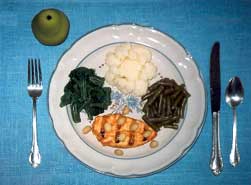When preparing
a zone meal
 |
When
preparing a zone meal using the eyeball method remember that every meal
starts with an adequate serving of low fat protein. Your protein portion
should be equal to the size and thickness of your palm. Remember the size
of your hand is relative to the size of your body and thus your protein
needs. If eating fish you can have a serving that is about the size of
your hand (including fingers). The same applies to a slice of turkey.
Most females require 3 ozs. of low fat protein per meal (21 grams) and
most males require 4 ozs. of low fat protein (28 grams).
A typical
female gets 77 grams of protein daily and a typical male gets 100 grams.
If
eyeballing on the plate, your low fat protein source would be approximately
1/3 of the plate.
Every
Zone meal requires an adequate serving of carbohydrates. Assuming you are
eating 3 ozs. of low fat protein, you then need to balance your plate with
3 carbohydrates. This can be either "favourable" (fruits and vegetables)
or "unfavourable" (pasta, grains, etc.). It is recommended if using unfavourable
carbs that they are no more than 25-33% of your Zone meal.
Favourable
carbohydrates (if using the eyeball method) means you can have two big,
loose fists worth. Unfavourable carbohydrates means you can have one tight
fist worth.
If
eyeballing on the plate, your carbohydrates will make up about 2/3 of the
plate.

Lastly,
don't forget your dietary fat. Every Zone meals requires an adequate serving
of dietary fat. Fat will improve the taste of food and slow down the entry
of carbohydrate into the blood stream.
Adding
a few nuts or olives or cooking your low fat protein source in olive oil
will help round out your Zone meal.
Just
remember that for approximately every 1 oz. of protein you get 1 carb and
1 fat. The ratio is 1:1:1.
So
if eating 3 ozs. of protein, you get 3 carbs and 3 fats. The ratio is now
3:3:3.
There
are some exceptions for the 1 oz. of protein however and this applies to
fish, deli meats and ground turkey or hamburger. You actually get 1 1/2
ozs. of meat for 1 protein.
Remember,
the Zone is a lifestyle and is not just learned overnight, but with patience
and perseverance one can find his or her centre.

|